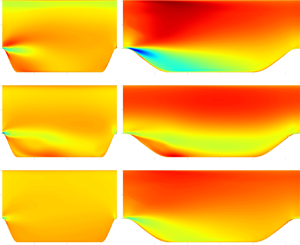Crossref Citations
This article has been cited by the following publications. This list is generated based on data provided by
Crossref.
Jiang, Chao
Vinuesa, Ricardo
Chen, Ruilin
Mi, Junyi
Laima, Shujin
and
Li, Hui
2021.
An interpretable framework of data-driven turbulence modeling using deep neural networks.
Physics of Fluids,
Vol. 33,
Issue. 5,
Ströfer, Carlos A. Michelén
and
Xiao, Heng
2021.
End-to-end differentiable learning of turbulence models from indirect observations.
Theoretical and Applied Mechanics Letters,
Vol. 11,
Issue. 4,
p.
100280.
McConkey, Ryley
Yee, Eugene
and
Lien, Fue-Sang
2022.
On the Generalizability of Machine-Learning-Assisted Anisotropy Mappings for Predictive Turbulence Modelling.
International Journal of Computational Fluid Dynamics,
Vol. 36,
Issue. 7,
p.
555.
Zhang, Zhen
Mao, Yinbo
Su, Xinrong
and
Yuan, Xin
2022.
Inversion learning of turbulent thermal diffusion for film cooling.
Physics of Fluids,
Vol. 34,
Issue. 3,
Hammond, James
Frey Marioni, Yuri
and
Montomoli, Francesco
2022.
Error Quantification for the Assessment of Data-Driven Turbulence Models.
Flow, Turbulence and Combustion,
Vol. 109,
Issue. 1,
p.
1.
McConkey, R.
Yee, E.
and
Lien, F. S.
2022.
Deep structured neural networks for turbulence closure modeling.
Physics of Fluids,
Vol. 34,
Issue. 3,
Sandberg, Richard D.
and
Zhao, Yaomin
2022.
Machine-learning for turbulence and heat-flux model development: A review of challenges associated with distinct physical phenomena and progress to date.
International Journal of Heat and Fluid Flow,
Vol. 95,
Issue. ,
p.
108983.
Berrone, S.
and
Oberto, D.
2022.
An invariances-preserving vector basis neural network for the closure of Reynolds-averaged Navier–Stokes equations by the divergence of the Reynolds stress tensor.
Physics of Fluids,
Vol. 34,
Issue. 9,
Xu, Xiaowei
Waschkowski, Fabian
Ooi, Andrew S.H.
and
Sandberg, Richard D.
2022.
Towards robust and accurate Reynolds-averaged closures for natural convection via multi-objective CFD-driven machine learning.
International Journal of Heat and Mass Transfer,
Vol. 187,
Issue. ,
p.
122557.
Li, Sen
He, Chuangxin
and
Liu, Yingzheng
2022.
A data assimilation model for wall pressure-driven mean flow reconstruction.
Physics of Fluids,
Vol. 34,
Issue. 1,
Amarloo, Ali
Forooghi, Pourya
and
Abkar, Mahdi
2022.
Frozen propagation of Reynolds force vector from high-fidelity data into Reynolds-averaged simulations of secondary flows.
Physics of Fluids,
Vol. 34,
Issue. 11,
Hammond, James
Pietropaoli, Marco
and
Montomoli, Francesco
2022.
Robust data-driven turbulence closures for improved heat transfer prediction in complex geometries.
International Journal of Heat and Fluid Flow,
Vol. 98,
Issue. ,
p.
109072.
Sáez de Ocáriz Borde, Haitz
Sondak, David
and
Protopapas, Pavlos
2022.
Convolutional neural network models and interpretability for the anisotropic reynolds stress tensor in turbulent one-dimensional flows.
Journal of Turbulence,
Vol. 23,
Issue. 1-2,
p.
1.
Liu, Yilang
Cao, Wenbo
Zhang, Weiwei
and
Xia, Zhenhua
2022.
Analysis on numerical stability and convergence of Reynolds averaged Navier–Stokes simulations from the perspective of coupling modes.
Physics of Fluids,
Vol. 34,
Issue. 1,
Zhang, Xin-Lei
Xiao, Heng
Luo, Xiaodong
and
He, Guowei
2022.
Ensemble Kalman method for learning turbulence models from indirect observation data.
Journal of Fluid Mechanics,
Vol. 949,
Issue. ,
Mandler, Hannes
and
Weigand, Bernhard
2022.
On frozen-RANS approaches in data-driven turbulence modeling: Practical relevance of turbulent scale consistency during closure inference and application.
International Journal of Heat and Fluid Flow,
Vol. 97,
Issue. ,
p.
109017.
Parekh, Jigar
and
Verstappen, R.W.C.P.
2023.
QUANTIFICATION AND PROPAGATION OF MODEL-FORM UNCERTAINTIES IN RANS TURBULENCE MODELING VIA INTRUSIVE POLYNOMIAL CHAOS.
International Journal for Uncertainty Quantification,
Vol. 13,
Issue. 2,
p.
1.
Tang, Hongwei
Wang, Yan
Wang, Tongguang
Tian, Linlin
and
Qian, Yaoru
2023.
Data-driven Reynolds-averaged turbulence modeling with generalizable non-linear correction and uncertainty quantification using Bayesian deep learning.
Physics of Fluids,
Vol. 35,
Issue. 5,
Cato, Arthur Shiniti
Volpiani, Pedro Stefanin
Mons, Vincent
Marquet, Olivier
and
Sipp, Denis
2023.
Comparison of different data-assimilation approaches to augment RANS turbulence models.
Computers & Fluids,
Vol. 266,
Issue. ,
p.
106054.
Li, Sen
He, Chuangxin
Wang, Weizhe
and
Liu, Yingzheng
2023.
Flow enhancement from wall pressure observations: A compressible continuous adjoint data assimilation model.
Physics of Fluids,
Vol. 35,
Issue. 11,




